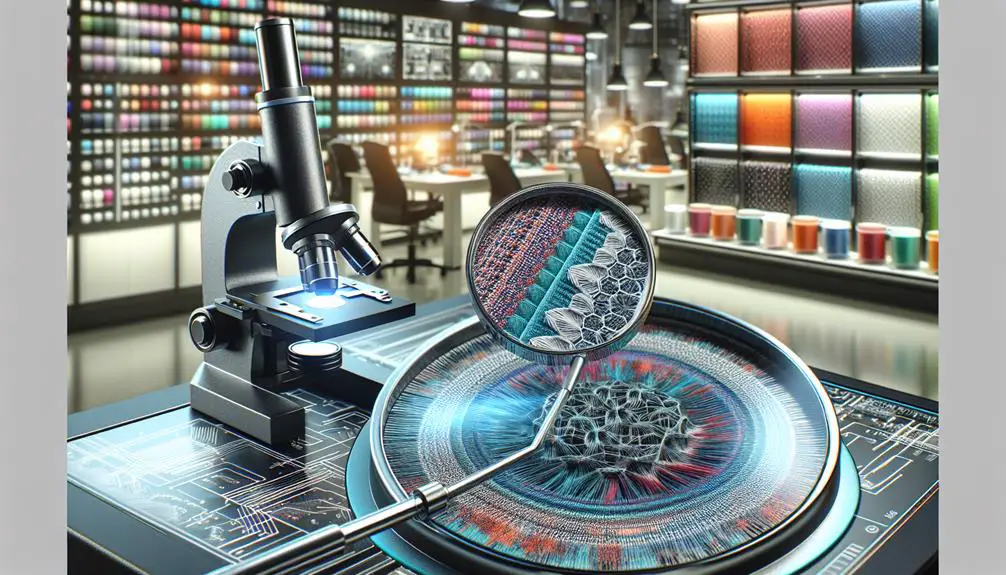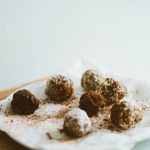Imagine the fabric of innovation weaving through the threads of technology and nature. When you think about performance fabrics, you're looking at a marvel of modern engineering, where every fiber is chosen with precision. These materials undergo advanced spinning, weaving, or knitting processes that transform them into high-performance textiles. Chemical treatments and functional coatings further enhance their capabilities, making them durable, moisture-wicking, and eco-friendly. But how exactly do these processes work, and what guarantees their reliability? There's much more to uncover about the intricate journey from raw materials to finished product.
Table of Contents
Key Takeaways
- Performance fabrics are engineered using advanced weaving and knitting techniques for enhanced durability and flexibility.
- Eco-friendly materials like recycled polyester and organic cotton are chosen to support sustainable practices.
- Chemical treatments are applied to improve moisture-wicking, stain resistance, and UV protection.
- Functional coatings add water repellency and enhance durability, making fabrics suitable for high-performance applications.
- Rigorous testing ensures fabric quality, including abrasion resistance, tensile strength, moisture management, UV protection, and colorfastness.
Selecting Raw Materials
When choosing raw materials for performance fabrics, you need to consider factors like durability, moisture-wicking ability, and breathability. These properties are vital for creating high-quality products that excel in demanding environments.
Begin with material sourcing. Selecting fibers known for their robustness and long-lasting performance is fundamental. Seek suppliers that prioritize quality, ensuring the raw materials meet the rigorous standards required for performance fabrics.
Innovation in fibers plays a significant role. Cutting-edge developments have resulted in the creation of materials that offer exceptional performance characteristics. For example, synthetic fibers such as polyester and nylon have been engineered to improve moisture management and breathability. These advancements not only enhance the fabric's functionality but also enhance its overall quality.
Sustainability is another crucial aspect. Choose eco-friendly materials whenever possible. Recycled polyester and organic cotton are excellent options that reduce environmental impact. By incorporating sustainable practices into your material sourcing strategy, you contribute to a more environmentally conscious industry while upholding the highest quality standards.
Fiber Spinning Techniques
Mastering fiber spinning techniques is essential for producing high-performance fabrics with peak durability and functionality. You'll need to understand the intricacies of both rotary spinning and melt spinning to achieve best possible results.
Rotary spinning involves extruding a polymer solution through a spinneret while rotating at high speeds. This technique creates fibers with enhanced tensile strength and uniformity. On the other hand, melt spinning is a process where polymers are heated until molten and then extruded through a spinneret. The fibers solidify as they cool, making them ideal for applications requiring high thermal resistance.
Here's a quick comparison to deepen your understanding:
| Technique | Key Characteristics |
|---|---|
| Rotary Spinning | High tensile strength, uniform fibers |
| Melt Spinning | High thermal resistance, solidifies on cooling |
| Applications | Sportswear, industrial textiles |
| Materials Used | Nylon, polyester |
| Advantages | Enhanced durability, versatility |
Each method has its unique benefits and applications. Rotary spinning is often used for creating fabrics that need to withstand significant wear and tear, while melt spinning is perfect for textiles exposed to high temperatures. By mastering these techniques, you'll be well-equipped to engineer fabrics that meet the most demanding performance standards.
Weaving and Knitting Processes
You'll find that both weaving and knitting are essential to creating performance fabrics.
Advanced weaving techniques guarantee durability and flexibility, while modern knitting innovations offer breathability and comfort.
Understanding these processes will help you appreciate the engineering behind your high-performance gear.
Advanced Weaving Techniques
In the world of performance fabrics, advanced weaving and knitting techniques play a crucial role in enhancing durability and functionality. You can't underestimate the importance of yarn construction in this process. By carefully designing and selecting the right types of yarns, you ensure that the resulting fabric meets specific performance criteria. This level of textile innovation means that each thread is engineered to deliver best strength, flexibility, and resistance to wear and tear.
When it comes to fabric durability, advanced weaving techniques are essential. Precision looms allow for intricate patterns and weaves that bolster the structural integrity of the material. Techniques like double-weaving and ripstop weaving create fabrics that are both lightweight and highly resistant to tearing. These methods are integral to performance technology, ensuring that the fabrics can withstand the rigorous demands placed upon them, whether in sportswear, outdoor gear, or high-performance applications.
Don't overlook the impact of these advanced techniques. They not only enhance the physical properties of the fabric but also contribute to its aesthetic appeal. By mastering these methods, you're able to produce textiles that offer unmatched quality and reliability in demanding environments.
Modern Knitting Innovations
Modern knitting innovations push the boundaries of textile engineering by incorporating advanced techniques that enhance fabric performance and versatility. One such breakthrough is circular knitting, which allows for the creation of tubes of fabric without seams. This method not only speeds up production but also results in garments that offer superior comfort and fit. Circular knitting machines can produce a wide array of patterns and textures, making them ideal for both functional and aesthetic applications.
Seamless construction is another revolutionary technique. By eliminating traditional seams, you reduce the risk of chafing and increase the durability of the garment. Seamless construction employs specialized knitting machines that can create complex, multi-dimensional fabrics in a single, continuous process. This method is particularly advantageous for performance wear, where flexibility and durability are paramount.
When you combine circular knitting with seamless construction, you get a powerful toolkit for creating high-performance fabrics. These methods allow for the integration of different fibers and yarns to achieve specific functional properties, such as moisture-wicking, breathability, and thermal regulation.
Chemical Treatments
Chemical treatments play a vital role in enhancing the durability and functionality of performance fabrics. You might wonder how these treatments contribute to durability enhancements and moisture-wicking properties.
By infusing fabrics with specialized chemicals, manufacturers can greatly extend the lifespan of the material, making it resilient against wear and tear. These treatments also optimize moisture-wicking capabilities, ensuring that sweat is efficiently drawn away from your skin, keeping you dry and comfortable during intense physical activities.
Furthermore, chemical treatments can impart stain resistance to performance fabrics. Imagine not having to worry about accidental spills or stains ruining your gear. These treatments form a protective barrier on the fabric surface, making it easier to clean and maintain.
Additionally, UV protection is another significant benefit brought by chemical treatments. By integrating UV-blocking agents into the fabric, you're shielded from harmful ultraviolet rays, reducing the risk of skin damage and extending the fabric's lifespan by preventing color fading.
Mastering the science of chemical treatments allows you to fully appreciate the sophisticated engineering behind performance fabrics. These enhancements aren't just about aesthetics; they're about delivering high-quality functionality to meet your rigorous demands.
Functional Coatings
While chemical treatments boost durability and functionality, functional coatings elevate performance fabrics by adding specialized layers that offer even more advanced properties. These coatings can deliver a range of benefits, from water repellency to enhanced durability, making them essential for high-performance applications.
You'll find that water repellency is one of the most desired characteristics in performance fabrics. By applying hydrophobic coatings, manufacturers guarantee that water beads up and rolls off the fabric surface, keeping it dry and functional even in wet conditions. This is particularly valuable for outdoor gear, sportswear, and protective clothing.
Durability enhancements are another significant advantage of functional coatings. These specialized layers can make fabrics more resistant to abrasion, tearing, and UV degradation. By strengthening the material's structural integrity, these coatings extend the lifespan of the fabric, making it a more sustainable choice for consumers and industries alike.
Functional coatings aren't just a superficial addition; they're carefully engineered to integrate seamlessly with the fabric's existing properties. Whether you're looking for advanced protection against the elements or seeking a fabric that can withstand rigorous use, functional coatings provide a sophisticated solution that elevates performance fabrics to unmatched levels.
Testing and Quality Control
Guaranteeing the reliability and performance of these fabrics requires rigorous testing and stringent quality control measures. You'll find that quality assurance is paramount in securing that performance fabrics meet the high expectations set forth by both manufacturers and consumers. Performance testing is conducted meticulously to assess various aspects of the fabric's capabilities.
By implementing these rigorous procedures, manufacturers can secure that every batch of fabric meets the required standards. Here's a closer look at some essential tests:
- Abrasion Resistance: Evaluates how well the fabric withstands wear and tear over time.
- Tensile Strength: Measures the fabric's ability to resist breaking under tension.
- Moisture Wicking: Assesses the fabric's efficiency in drawing moisture away from the body.
- UV Protection: Determines the fabric's ability to shield against harmful ultraviolet rays.
- Colorfastness: Checks how well the fabric maintains its color when exposed to various conditions like washing and sunlight.
Each of these tests plays a critical role in quality assurance, securing that the performance fabrics live up to their engineered potential.
Sustainable Practices
Incorporating sustainable practices into the production of performance fabrics not only benefits the environment but also meets the growing consumer demand for eco-friendly products.
You'll find that eco-friendly innovations are redefining how these fabrics are engineered, making sustainability a core aspect of modern textile manufacturing.
One of the key strategies is the adoption of circular economy practices. Instead of following the traditional linear model of 'take, make, dispose,' manufacturers are now focusing on recycling and reusing materials.
For instance, some companies utilize recycled polyester derived from plastic bottles, reducing waste and conserving resources. This approach not only minimizes environmental impact but also maintains the high-performance characteristics consumers expect.
Moreover, advances in dyeing technologies notably reduce water and energy consumption. By adopting waterless dyeing methods, you can guarantee vibrant colors while conserving precious resources.
Additionally, biodegradable performance fabrics are emerging, designed to break down naturally at the end of their lifecycle without leaving harmful residues.
Frequently Asked Questions
How Do Performance Fabrics Impact Athletic Performance and Comfort?
Performance fabrics greatly improve athletic performance and comfort. With advanced fabric technology, they offer breathability and moisture-wicking properties, keeping you dry. Their durability guarantees they withstand intense activity, making them essential for serious athletes.
What Are the Common Applications of Performance Fabrics in Everyday Life?
You'll find performance fabrics in home decor, outdoor gear, fashion, and healthcare. They're used in everyday items like curtains, tents, activewear, and medical scrubs, enhancing durability, comfort, and functionality in various aspects of daily life.
Are Performance Fabrics More Expensive Than Traditional Fabrics?
Did you know performance fabrics can be up to 25% more expensive than traditional fabrics? However, when you consider their cost comparison, the durability benefits often justify the investment, making them a smart choice for long-term use.
How Do I Care for and Maintain Performance Fabrics?
To care for and maintain performance fabrics, follow specific washing instructions and drying techniques. For stain removal, use mild detergents. Avoid high heat to guarantee fabric longevity. Consistent proper care will keep your fabrics in top condition.
What Are the Latest Innovations in Performance Fabric Technology?
Imagine the cutting-edge of performance fabrics: they now focus on sustainability and durability. You'll find innovations enhancing versatility and breathability, offering superior comfort and adaptability, much like the mythic fabrics of old, but eco-friendly and long-lasting.
- The Surprising Origin of Angora: It’s Not From a Goat - July 2, 2025
- How Is Angora Wool Made? From Rabbit to Runway - July 2, 2025
- Angora Fabric 101: Everything You Need to Know - July 2, 2025





